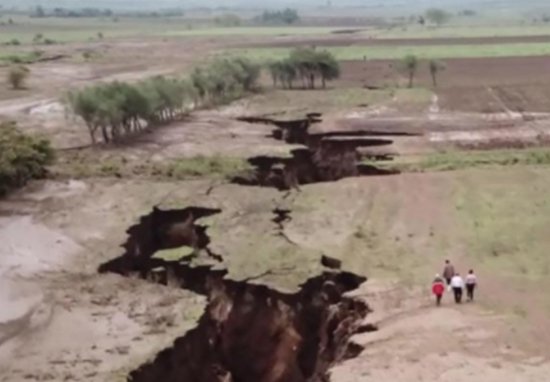A large crack, stretching several kilometres, made a sudden appearance recently in south-western Kenya. The tear, which continues to grow, caused part of the Nairobi-Narok highway to collapse and was accompanied by seismic activity in the area.
Now scientists are claiming that in millions of years the African continent could split two.
In an article for the Conversation, Lucia Perez Diaz, Pa ostdoctoral Researcher at the Fault Dynamics Research Group, London’s Royal Holloway, explains how this could happen.
The Earth is an ever-changing planet, even though in some respects change might be almost unnoticeable to us.
Plate tectonics is a good example of this. But every now and again something dramatic happens and leads to renewed questions about the African continent splitting in two.
How the rift formed
The Earth’s lithosphere (formed by the crust and the upper part of the mantle) is broken up into a number of tectonic plates.
These plates are not static, but move relative to each other at varying speeds, ‘gliding’ over a viscous asthenosphere.
Exactly what mechanism or mechanisms are behind their movement is still debated, but are likely to include convection currents within the asthenosphere and the forces generated at the boundaries between plates.
These forces do not simply move the plates around, they can also cause plates to rupture, forming a rift and potentially leading to the creation of new plate boundaries.
The East African Rift system is an example of where this is currently happening.
What is the East African rift?
The East African Rift Valley stretches over 3,000km from the Gulf of Aden in the north towards Zimbabwe in the south, splitting the African plate into two unequal parts: the Somali and Nubian plates.
Activity along the eastern branch of the rift valley, running along Ethiopia, Kenya and Tanzania, became evident when the large crack suddenly appeared in south-western Kenya.
Why does rifting happen?
When the lithosphere is subject to a horizontal extensional force it will stretch, becoming thinner. Eventually, it will rupture, leading to the formation of a rift valley.
This process is accompanied by surface manifestations along the rift valley in the form of volcanism and seismic activity.
Rifts are the initial stage of a continental break-up and, if successful, can lead to the formation of a new ocean basin.
An example of a place on Earth where this has happened is the South Atlantic ocean, which resulted from the break up of South America and Africa around 138m years ago – ever noticed how their coastlines match like pieces of the same puzzle?.
Continental rifting requires the existence of extensional forces great enough to break the lithosphere.















